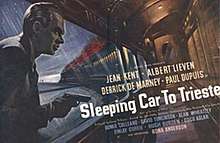Sleeping Car to Trieste
| Sleeping Car to Trieste | |
|---|---|
 | |
| Directed by | John Paddy Carstairs |
| Produced by | George H. Brown |
| Written by | Allan MacKinnon |
| Based on | story by Clifford Grey |
| Starring |
Jean Kent Albert Lieven Derrick De Marney Paul Dupuis Rona Anderson David Tomlinson |
| Music by | Benjamin Frankel |
| Cinematography | Jack Hildyard |
| Edited by | Sidney Stone |
Production company | |
| Distributed by |
General Film Distributors Eagle-Lion Classics (USA) J. Arthur Rank Film (UK) |
Release date |
|
Running time | 95 minutes |
| Country | United Kingdom |
| Language | English |
Sleeping Car to Trieste is a 1948 British film directed by John Paddy Carstairs. It is a remake of the 1932 film Rome Express.
Plot
The setting is almost entirely on a train travelling between Paris and Trieste in post-war Europe. Two rather mysterious people, Zurta (Albert Lieven) and Valya (Jean Kent), are at ease in sophisticated society. On Valya's behalf, Zurta steals a diary from an embassy in Paris, but, in doing so, kills an embassy guard. Poole, an accomplice, is passed the diary, but he double-crosses them and attempts to escape with it on the Orient Express. Just in time, Valya and Zurta also board the train.
They start tracking down Poole, who is trying to stay hidden in a train compartment. Other travellers become involved, including a US Army sergeant with an eye for the ladies, an adulterous couple, an idiot stockbroker, a wealthy, autocratic writer and his brow-beaten secretary/valet, a bird watcher, and a French police inspector. The train staff and other passengers provide some more light-hearted scenes.
The diary is discovered by accident and passes through the hands of several people on the train. Zurta
is eventually confronted by the police inspector on suspicion of having killed Poole. He regains the diary and attempts to escape by leaping from the train, but lands directly in the path of a train travelling in the opposite direction.
Cast
- Jean Kent as Valya
- Albert Lieven as Zurta
- Derrick De Marney as George Grant
- Paul Dupuis as Inspector Jolif
- Rona Anderson as Joan Maxted
- David Tomlinson as Tom Bishop
- Bonar Colleano as Sergeant West
- Finlay Currie as Alastair MacBain
- Grégoire Aslan as Poirier, the chef (as Coco Aslan)
- Alan Wheatley as Karl/Charles Poole
- Hugh Burden as Mills
- David Hutcheson as Denning
- Claude Larue as Andrée
- Zena Marshall as Suzanne
- Leslie Weston as Randall
- Michael Ward as Elvin
- Eugene Deckers as Jules
Production
The film was originally known as Sleeping Car to Vienna.[1]
Rona Anderson made her film debut.[2] "I did enjoy doing it", said Anderson. "It was a film full of nice little cameo performances.... Paddy Carstairs had a good way of relaxing you and I think he had a very good way with actors generally."[3]
It was the one movie Albert Lieven made while under contract to Rank for five years.[4]
However Jean Kent later stated she "didn't like" the film "and didn't get on very well" with Carstairs. "You never knew where you were with him... I don't remember enjoying it. I had silly clothes. I wanted to be very French in plain black and a little beret but I had to wear these silly New Look clothes. I was playing a superspy of some kind. But who was I spying for?"[5]
Release
The film proved more popular in the US than most British films, enjoying a long run in New York.[6]
The New York Times wrote, "not without its trying moments, but on the whole it is a mighty interesting ride...The director John Paddy Carstairs shrewdly maneuvers the pursuers and the hunted about the train in a natural and credible manner so that the possibility of an imminent meeting creates a good deal of tension...None of the principals is too familiar to audiences here, and at times dialogue is lost in some of the players' throats, but the performances are generally satisfying."[7]
References
- ↑ "Lockwood happy in new role". The Sun (2359). New South Wales, Australia. 27 June 1948. p. 31 (STUMPS). Retrieved 28 September 2017 – via National Library of Australia.
- ↑ "Film Stars in Britain". Western Mail. Perth. 22 July 1948. p. 15. Retrieved 20 April 2014 – via National Library of Australia.
- ↑ Brian McFarlane, An Autobiography of British Cinema by the Actors and Filmmakers Who Made It, Methuen 1997 p 17
- ↑ "IDLE STAR GETS ROLE AT LAST". The Sun (2491). Sydney. 14 January 1951. p. 38. Retrieved 28 September 2017 – via National Library of Australia.
- ↑ Brian McFarlane, An Autobiography of British Cinema by the Actors and Filmmakers Who Made It, Methuen 1997 p 340
- ↑ "Mary Armitages: FILM CLOSE-UPS". The Mail. Adelaide. 27 August 1949. p. 2 Supplement: SUPPLEMENT TO "THE MAIL.". Retrieved 20 April 2014 – via National Library of Australia.
- ↑ https://www.nytimes.com/movie/review?res=9806E1D6103EE03BBC4052DFB2668382659EDE
External links
- Sleeping Car to Trieste on IMDb
- Sleeping Car to Trieste at AllMovie
- Review of film at Variety